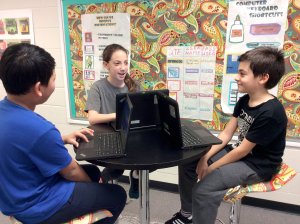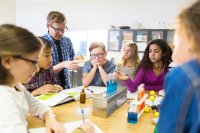21st-Century Learning Starting in Elementary School
A group of Georgia schools work together to emphasize project-based learning and STEM courses from the elementary years through 12th grade.
Your content has been saved!
Go to My Saved Content.Learning about weather-related natural disasters is serious business for the budding meteorologists at White Oak Elementary School in Sugar Hill, Georgia. For a recent STEM (science, technology, engineering, and math) project, one team of fifth graders drafted emergency response plans that they planned to present to an audience of civil engineers. Another team mapped out a field trip for younger children to help them understand weather patterns. Other students contemplated how they might use Minecraft or produce videos to share what they had learned through their weather investigations.
When Principal Jean Loethen-Payne observes inquiry projects, she wants to see students “creating their wonders, writing for a purpose, thinking about their audience, and preparing to go public.” Content goals also matter, but Loethen-Payne knows that textbook learning alone won’t prepare students for the challenges ahead. “How are we building 21st-century skills,” she asks, “to get our kids where they need to be by high school?”
It’s not a theoretical question. White Oak Elementary is part of the Lanier Cluster, a group of schools within the sprawling Gwinnett County school district that emphasize project-based learning (PBL), STEM, and 21st-century skills. The challenges that await students in middle and high school include authentic problem solving with community partners, technology-driven innovation, and internships in the world beyond school. The sooner they develop a 21st-century skill set and mindset, the better. P21—the Partnership for 21st-Century Learning—recently designated the Lanier Cluster an exemplar of 21st-century learning.
Starting With a Foundation
Building a pipeline for 21st-century learning doesn’t mean that instruction looks the same at every grade level.
At White Oak Elementary, teachers build a strong foundation by alternating between PBL and more traditional units, typically doing at least one major project within each nine-week period. Even when teachers are not leading a project, they emphasize inquiry and use the workshop model for reading, math, and writing.

From kindergarten through fifth grade, teachers reinforce the skills needed for student-driven learning. Planning documents shared on Google, for example, help students learn to manage their time and be accountable to team members. Explicit lessons in collaboration “are unfolded again and again,” Loethen-Payne says.
At Lanier Middle School, students can continue developing their 21st-century skills by applying to be part of an interdisciplinary program called TWIST, or Teamwork With Innovative Skills and Technology.
Ready for Innovation
Once students start Lanier High School, even more self-directed learning experiences await. Students can choose from four academies, each with a different career focus.
The most project-based of the academies is the Center for Design and Technology. Since it opened as a pilot with 30 ninth graders in 2010, CDAT has expanded to include more than 400 students in grades 9 to 12. CDAT projects are deliberately open-ended and interdisciplinary, giving students considerable leeway about how to demonstrate and apply what they learn.
A recent project, for example, was inspired by Professor Randy Pausch’s famous “last lecture” TED talk. Language arts teacher Naomi Kirchner challenged students to emulate Pausch and bring something to the table reflecting their interests or passions. They used technology skills to promote that aspect of themselves as if they were pitching for a job interview or internship.
In another project, students had to apply language arts and technology skills to survive a zombie contagion.
“We don’t have a [PBL] formula,” says Mike Reilly, CDAT’s founder and the innovation coach for the Lanier Cluster. He has had motivated students earn patents for their inventions and attract the attention of area businesses.
CDAT gradually builds students’ independence as they move through the program. Freshmen get coaching on the process of doing projects and gain an introduction to a variety of technology tools. Sophomores go deeper into their interests, such as coding, engineering, or film production. Juniors tackle one yearlong capstone project, such as producing a documentary film, programming an autonomously driven vehicle, or launching a community service initiative. Seniors have the freedom to leave campus for internships or dual enrollment programs to start earning college credit.
“The number one thing I hear about our students,” Reilly says, “is that our kids talk [to visitors] in a way that most high school kids don’t. They’re better communicators and collaborators because they have so much dialogue with the instructor and with other students.”
Teacher Ownership
Across the Lanier cluster, teachers also have opportunities to learn together.
At White Oak Elementary, Loethen-Payne has emphasized teacher collaboration since she opened the school in 2009. “We need to work as a team and look for the best answers together to create what’s best for our kids,” she says.
Similarly, the growth of CDAT “has been teacher-led and organic, not top-down,” says Kirchner. She appreciates having common planning time with the grade 10 team and regular opportunities “to bump into each other in the hallways, have lunch together, and talk things over together. We collaborate constantly.”
Despite much progress, the pipeline for 21st-century learning isn’t perfect, Reilly acknowledges. Across the Lanier Cluster, PBL does not yet reach every student. But students who arrive at high school with a strong foundation of 21st-century skills, as Reilly explains, show “a clear difference.”
